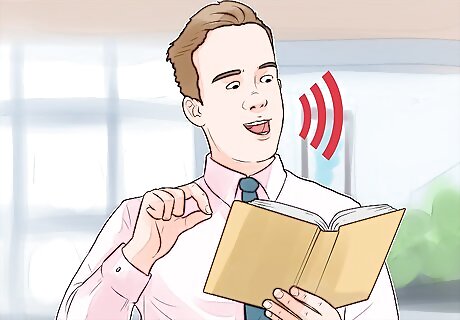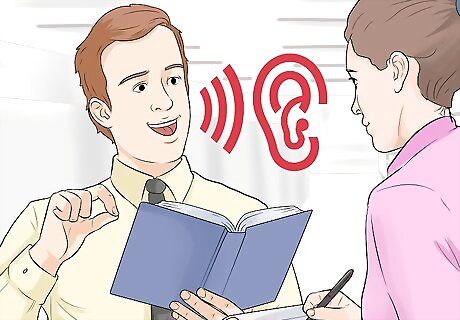
views
Speaking More Clearly

Enunciate each word more clearly. One of the biggest problems for people who speak too quickly is that they often blur words together in a way that can be difficult to understand. Spend some time practicing how you enunciate words, especially when you string them together in a sentence. Don't skip over any words, not even the small ones. Enunciate each syllable of every word.

Practice tongue twisters. Tongue twisters are designed to help you work out the muscles in your mouth, and improve your own pronunciation. Try various tongue twisters to help you warm up your voice before a speech, or just to help you slow down your vocal cadence in general. Try saying, “The lips, the teeth, the tip of the tongue” over and over. Exaggerate each syllable. Repeat the words “rubber baby buggy bumpers.” Say each word clearly. Repeat the phrase again and again.

Stretch your vowel sounds. While practicing your enunciation, try stretching your vowel sounds to add length to each word. This will help you speak more slowly and more clearly. Exaggerate it at first and add a short pause between each word. Over time, this will help you learn to not link your words together so intensely while still enunciating each word clearly.
Using Pauses and Speed Controls

Add pauses at appropriate times. Many people who speak too fast skip over places where pauses would make sense in normal conversation. This includes between sentences, after a major piece of information, and when the topic changes. Try to make a conscious effort to add more pauses while you are speaking. You may need to pause between each word, or add extra-long pauses after important information.

Allow yourself to occasionally use filler words. Filler words are conversational tools that allow the listener to better understand the topic, and also provide the speaker with time to think before completing a response. Allowing yourself to occasionally use these words in your speech can help you slow down your presentation. It can also allow your audience to connect more strongly with what you're saying. These include things like “um,” “uh,” “I mean,” “you know,” and “like.” Keep in mind that using too many filler words can make it look like you are struggling to find the right words, or don't know the answer. Use these sparingly, and only as a means to help you slow down your speech.

Breathe more frequently. Sometimes people hold their breath a bit, or speak more quickly in order to get through more of the words in one breath. If you want to speak more slowly, make a concerted effort to breathe more often while you are speaking. If you have a typed speech, you should consider adding notes for yourself to remember when to breathe and to do it more frequently than you normally would.

Make eye contact with your listener. When you are giving a speech or talking to other people, it can be helpful to make eye contact with whoever is listening. By practicing this trick, you will be waiting for verbal or body language cues from your listener(s) before you move on with your topic. This means that you will be forced to slow down to accommodate your audience. Speaking more slowly and engaging with your audience with eye contact will help them keep up with you and understand what you're talking about.

Practice self-calming techniques. Talking too fast is often caused by anxiety or nervousness in speaking situations. It can be helpful to practice calming yourself down so that you can slow down the rhythm of your speech. Try counting your breaths slowly. Inhale deeply and exhale slowly. Count each breath and continue this practice for one to five minutes. Try clenching and releasing your muscles. Start with the muscles at the top and work your way down. Clench the muscles in your forehead and face while you breathe in. Hold the breath for a moment and then slowly release it, unclenching the muscles as you go. Repeat this process as you work your way down your body, clenching and releasing all of your muscles.
Practicing Your Speech Out Loud

Read texts aloud at varying speeds. Try reading a passage out loud at your normal speed, and then try reading it faster than your normal speed. This will make any other tempo seem slower. Next, re-read the text with a conscious effort to read it more slowly Then continue slowing down until it seems exaggeratedly slow. With practice, this kind of speed alteration will help you learn how to control the tempo of your voice.

Read texts aloud at varying volumes. Read a passage aloud at your normal volume. Then try reading it aloud in a whispered voice. Practice reading things in a whispered tone. The extra effort put into expelling the air out at a softer volume will automatically slow down your monologue. Try to inhale deeply and then expel all of the air while you complete a single phrase. Pause between phrases.

Record yourself speaking. A lot of people have trouble hearing the problems that occur in their own speeches, especially in the moment during a presentation or speech. Record yourself while you are speaking – preferably during a live presentation, not just a practice session – so you can listen to yourself and critique your mistakes. Play the recording when you are alone and have some time to analyze what you hear. Try practicing the same speech again, but make a conscious effort to alter some of the issues you noticed in the recording. Think about places in which your speech seemed especially fast, and practice slowing down especially in those moments.

Ask someone to listen to you and provide feedback. Ask a trusted friend or colleague to listen to you when you are speaking and to jot down a few notes for you. After the presentation is over, ask the person for any thoughts, especially related to the speed of your speech. Try to take their criticism in a good natured manner. Remember that you asked them to do this for you.


















Comments
0 comment